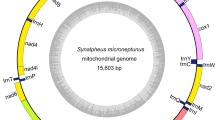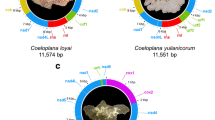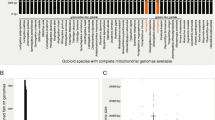Abstract
Poriferan mitochondrial DNA (mtDNA), especially large intergenic regions, is a target for the insertion of repetitive hairpin-forming elements. These elements are responsible for the large mt genome size differences observed even among closely related sponge taxa. In this study, we present the new, nearly complete, mt genome sequence of Ephydatia fluviatilis and compare it with previously published mt genomes of freshwater sponges. Special emphasis was placed on comparison with the closely related species Ephydatia muelleri, thereby comparing the only two species of the genus Ephydatia on the western Balkan Peninsula. In particular, we analyzed repetitive palindromic elements within the mitochondrial intergenic regions. The genomic distribution of these repetitive elements was analyzed and their potential role in the evolution of mt genomes discussed. We show here that palindromic elements are widespread through the whole mt genome, including the protein coding genes, thus introducing genetic variability into mt genomes.





Similar content being viewed by others
References
Abascal, F., Zardoya, R., & Posada, D. (2005). ProtTest: selection of best-fit models of protein evolution. Bioinformatics, 21, 2104–2105.
Addis, J. S., & Peterson, K. J. (2005). Phylogenetic relationships of freshwater sponges (Porifera, Spongillina) inferred from analyses of 18s rDNA, COI mtDNA, and ITS2 rDNA sequences. Zoologica Scripta, 34, 549–557.
Aono, N., Shimizu, T., Inoue, T., & Shiraishi, H. (2002). Palindromic repetitive elements in the mitochondrial genome of Volvox. FEBS Letters, 521, 95–99.
Benson, D. A., Karsch-Mizrachi, I., Lipman, D. J., Ostell, J., & Wheeler, D. L. (2003). GenBank. Nucleic Acids Research, 31, 23–27.
Castresana, J. (2000). Selection of conserved blocks from multiple alignments for their use in phylogenetic analysis. Molecular Biology and Evolution, 17, 540–552.
Drummond, A., & Strimmer, K. (2001). PAL: an object-oriented programming library for molecular evolution and phylogenetics. Bioinformatics, 17, 662–663.
Erpenbeck, D., Voigt, O., Adamski, M., Adamska, M., Hooper, J. N., Worheide, G., & Degnan, B. M. (2007). Mitochondrial diversity of early-branching metazoa is revealed by the complete mt genome of a haplosclerid demosponge. Molecular Biology and Evolution, 24, 19–22.
Erpenbeck, D., Voigt, O., Worheide, G., & Lavrov, D. V. (2009). The mitochondrial genomes of sponges provide evidence for multiple invasions by Repetitive Hairpin-forming Elements (RHE). BMC Genomics, 10, 591.
Guindon, S., & Gascuel, O. (2003). PhyML: "a simple, fast, and accurate algorithm to estimate large phylogenies by maximum likelihood.". Systematic Biology, 52(5), 696–704.
Harcet, M., Bilandzija, H., Bruvo-Madaric, B., & Cetkovic, H. (2010). Taxonomic position of Eunapius subterraneus (Porifera, Spongillidae) inferred from molecular data-a revised classification needed? Molecular Phylogenetics and Evolution, 54, 1021–1027.
Itskovich, V., Belikov, S., Efremova, S., Masuda, Y., Perez, T., Alivon, E., Borchiellini, C., & Boury-Esnault, N. (2007). Phylogenetic relationships between freshwater and marine Haplosclerida (Porifera, Demospongiae) based on the full length 18s rRNA and partial COXI gene sequences. In M. R. Custodio, G. Lobo-Hajdu, E. Hajdu, & G. Muricy (Eds.), Porifera Research: Biodiversity, innovation and sustainability (pp. 383–391). Rio de Janeiro: Museu Nacional.
Koll, F., Boulay, J., Belcour, L., & d'Aubenton-Carafa, Y. (1996). Contribution of ultra-short invasive elements to the evolution of the mitochondrial genome in the genus Podospora. Nucleic Acids Research, 24, 1734–1741.
Lang, B. F., O'Kelly, C. J., & Burger, G. (1998). Mitochondrial genomics in protists, an approach to probing eukaryotic evolution. Protist, 149, 313–322.
Lavrov, D. V., Forget, L., Kelly, M., & Lang, B. F. (2005). Mitochondrial genomes of two demosponges provide insights into an early stage of animal evolution. Molecular Biology and Evolution, 225, 1231–1239.
Lavrov, D. V. (2007). Key transitions in animal evolution: a mitochondrial DNA perspective. Integrative and Comparative Biology, 47, 734–743.
Lavrov, D. V. (2010). Rapid proliferation of repetitive palindromic elements in mtDNA of the endemic Baikalian sponge Lubomirskia baicalensis. Molecular Biology and Evolution, 27, 757–760.
Lavrov, D. V., Maikova, O. O., Pett, W., & Belikov, S. (2012). Small inverted repeats drive mitochondrial genome evolution in Lake Baikal sponges. Gene, 505, 91–99.
Lukić-Bilela, L., Brandt, D., Pojskić, N., Wiens, M., Gamulin, V., & Müller, W. E. G. (2008). Mitochondrial genome of Suberites domuncula: palindromes and inverted repeats are abundant in non-coding regions. Gene, 412, 1–11.
Lowe, T. M., & Eddy, S. R. (1997). tRNAscan-SE: a program for improved detection of transfer RNA genes in genomic sequence. Nucleic Acids Research, 31, 176–178.
Manconi, R., & Pronzato, R. (2002). Suborder Spongillina subord. nov. freshwater sponges. In J. N. A. Hooper & R. W. M. van Soest (Eds.), Systema Porifera. A guide to the classification of sponges. Vol. 1 (pp. 921–1019). New York: Kluwer Academic/Plenum.
Meixner, M. J., Luter, C., Eckert, C., Itskovich, V., Janussen, D., von Rintelen, T., Bohne, A. V., Meixner, J. M., & Hess, W. R. (2007). Phylogenetic analysis of freshwater spongees provide evidence for endemisim and radiation in ancient lakes. Molecular Phylogenetics and Evolution, 45, 875–886.
Nakazono, M., Kanno, A., Tsutsumi, N., & Hirai, A. (1994). Palindromic repeated sequences (PRSs) in the mitochondrial genome of rice: evidence for their insertion after divergence of the genus Oryza from the other Gramineae. Plant Molecular Biology, 24, 273–281.
Nedelcu, A. M., & Lee, R. W. (1998). Short repetitive sequences in green algal mitochondrial genomes: potential roles in mitochondrial genome evolution. Molecular Biology and Evolution, 15, 690–701.
Nei, M., & Kumar, S. (2000). Molecular evolution and phylogenetics. New York: Oxford University Press.
Ogata, H., Audic, S., Barbe, V., Artiguenave, F., Fournier, P. E., Raoult, D., & Claverie, J. M. (2000). Selfish DNA in protein-coding genes of Rickettsia. Science, 290, 347–350.
Paquin, B., Laforest, M. J., & Lang, B. F. (2000). Double-hairpin elements in the mitochondrial DNA of allomyces: evidence for mobility. Molecular Biology and Evolution, 17, 1760–1768.
Pleše, B., Lukić-Bilela, L., Bruvo-Mađarić, B., Harcet, M., Imesek, M., Bilandžija, H., & Ćetković, H. (2011). The mitochondrial genome of stygobitic sponge Eunapius subterraneus: mtDNA is highly conserved in freshwater sponges. Hydrobiologia, 687, 49–59. doi:10.1007/s10750-011-0789-y.
Rice, P., Longden, I., & Bleasby, A. (2000). EMBOSS: the European Molecular Biology Open Software Suite. Trends in Genetics, 16(6), 276–277.
Rosengarten, R. D., Sperling, E. A., Moreno, M. A., Leys, S. P., & Dellaporta, S. L. (2008). The mitochondrial genome of the hexactinellid sponge Aphrocallistes vastus: evidence for programmed translational frameshifting. BMC Genomics, 9, 33.
Smith, D. R., & Lee, R. W. (2009). The mitochondrial and plastid genomes of Volvox carteri: bloated molecules rich in repetitive DNA. BMC Genomics, 10, 132.
Tamura, K., Peterson, D., Peterson, N., Stechter, G., Nei, M., & Kumar, S. (2011). MEGA5: molecular evolutionary genetics analysis using likelihood, distance, and parsimony methods. Molecular Biology and Evolution, 28, 2731–2739. doi:10.1093/molbev/msr121.
Thompson, J. D., Higgins, D. G., & Gibson, T. J. (1994). CLUSTAL W: improving the sensitivity of progressive multiple sequence alignment through sequence weighting, position-specific gap penalties and weight matrix choice. Nucleic Acids Research, 22, 4673–4680.
Wang, X. J., & Lavrov, D. V. (2008). Seventeen New Complete mtDNA sequences reveal extensive mitochondrial genome evolution within the Demospongiae. PloS One, 3(7), e2723. doi:10.1371/journal.pone.0002723.
Weiller, G., Schueller, C. M., & Schweyen, R. J. (1989). Putative target sites for mobile G + C rich clusters in yeast mitochondrial DNA: single elements and tandem arrays. Molecular and General Genetics, 218, 272–283.
Wenzlau, J. M., & Perlman, P. S. (1990). Mobility of two optional G + C-rich clusters of the var1 gene of yeast mitochondrial DNA. Genetics, 126, 53–62.
Acknowledgments
This work was supported by the Croatian Ministry of Science, Education and Sports [grant number 098-0982913-2874] (H. Ćetković). We thank Helena Bilandžija and Branko Jalžić, members of the Croatian Biospeleological Society, for their help with specimen collection.
Author information
Authors and Affiliations
Corresponding authors
Rights and permissions
About this article
Cite this article
Imešek, M., Pleše, B., Lukić-Bilela, L. et al. Mitochondrial genomes of the genus Ephydatia Lamouroux, 1816: can palindromic elements be used in species-level studies?. Org Divers Evol 13, 127–134 (2013). https://doi.org/10.1007/s13127-012-0118-y
Received:
Accepted:
Published:
Issue Date:
DOI: https://doi.org/10.1007/s13127-012-0118-y




